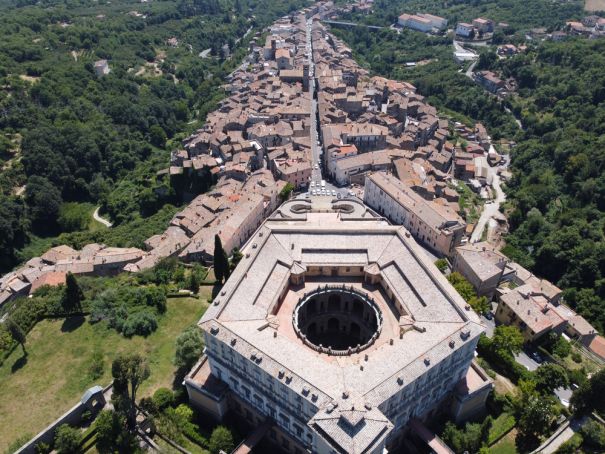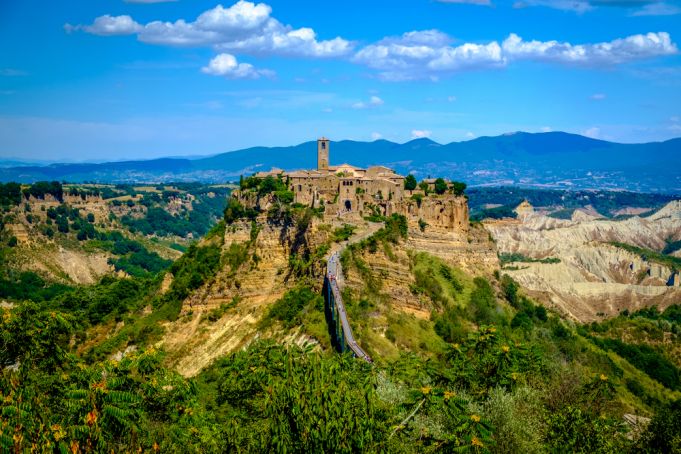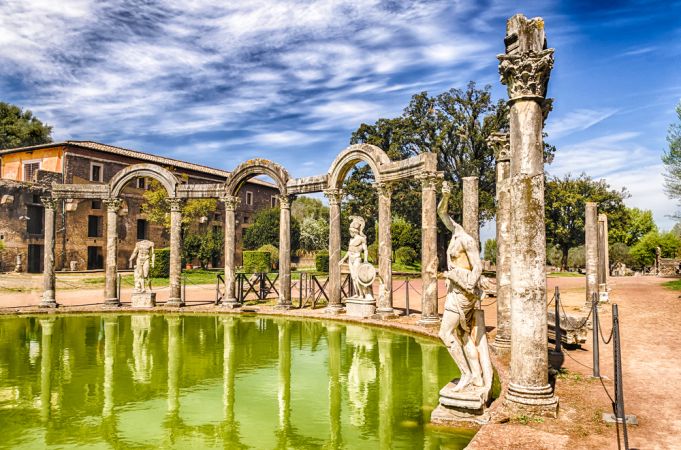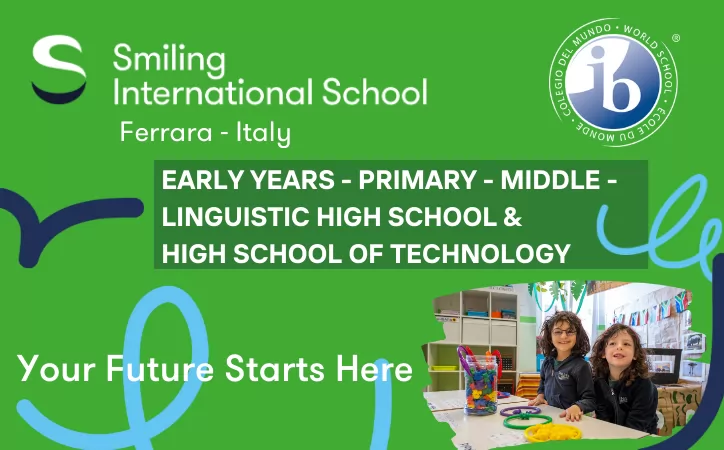A short guide to exploring seven charming hilltop towns and villages in Italy's central Lazio region and how to get there on day trips from Rome.
Bomarzo
This mediaeval town in north Lazio is best known for its fantastical Parco dei Mostri or “park of monsters”. Designed by Renaissance architect Pirro Ligorio with the aim of astonishing visitors, this wondrous park features grotesque mythological sculptures and fountains, including the gaping Orcus, Hannibal's elephant, Pegasus the winged horse and a disorientating leaning house.How to get to Bomarzo from Rome
By train: Trains from Roma Termini to Attigliano-Bomarzo station take around 55 minutes. Trains from Rome also reach nearby Orte and Viterbo, with Cotral buses to Bomarzo operating from both towns.
Driving: 93 km north from Rome to Bomarzo via A1 / E35. The drive takes about an hour and a half.
Calcata
This craggy hamlet north of Rome was condemned in the 1930s over fears of its impending collapse, and its residents were relocated to the newly-built “Calcata Nuova”. In the 1960s however old Calcata slowly came back to life with the arrival of artists who squatted in its abandoned houses and caves. The hippy atmosphere prevails today, with The New York Times describing Calcata as “the grooviest village in Italy”. There are numerous restaurants and craft shops, and the Monte Gelato waterfalls are close by.
By train/bus: There are no direct trains from Rome. Take the 20-minute journey on the light-rail train service from Via Flaminia in Rome to Saxa Rubra, then hop aboard one of the blue Cotral buses to Calcata Vecchia. Buses leave regularly, and the trip takes a little over an hour, however it is best to consult all connections before making the journey.
Driving: Approx 53 km north from Rome to Calcata via SS2, exit Settevene and follow signs for Calcata. The drive takes about one hour.
Caprarola
Located on the southern slope of the densely-wooded Cimini mountains, Caprarola is a town in the Viterbo province, about 50km north-west of Rome. It is best known for its magnificent Palazzo Farnese, a five-sided Renaissance palace dating to the late 16th century, and the formal gardens that surround it. The pentagonal palace, also known as Villa Farnese, is famous for its Mannerist frescoes and spectacular winding staircase.
By train: There is no direct service but trains run from Roma Termini to Orte (approx 40 mins). From Orte, you can take a taxi but be warned that the roughly half-hour trip will cost between €50 and €65.
By bus: From Piazzale Flaminio take a bus to Saxa Rubra (13 mins) before transferring to a Cotral bus to Caprarola (approx 1 hour and 10 mins).
Driving: Approximately 60 km north from Rome to Caprarola via SR2. The drive takes about one hour and 20 mins.
Civita di Bagnoregio
Regarded by many as the jewel in the crown of Lazio's hilltop villages, Civita surges out of the Calanchi valley in the northern Viterbo province. The tiny hamlet is known as “the dying town” due to the erosion and landslides that have chipped away at its fragile base over the centuries, from the Etruscan era to the modern day. Only about a dozen residents still live in Civita which is reached by a steep pedestrian bridge, and is seeking World Heritage recognition from UNESCO.
By train/ bus: Trains leave from Roma Termini to Orvieto whose station is connected to nearby Bagnoregio by Cotral bus. You can also reach Bagnoregio by Cotral bus from Viterbo Porta Fiorentina (trains from Roma Ostiense) but the Orvieto option is less complicated. The coaches do not run regularly so check times before travelling. Orvieto is 20km away from Bagnoregio, Viterbo 30km, both bus trips take about an hour.
Driving: Approximately 120 km north from Rome to Bagnoregio, taking the Orvieto exit off A1 motorway. The drive takes around one hour and 50 mins.
Cervara di Roma
Located about 70 km from Rome in the Simbruini regional park, Lazio's largest nature reserve, Cervara offers sweeping views of the Aniene valley. With origins dating back to the eighth century, for 200 years the natural beauty surrounding Cervara has attracted artists from all over Europe, traces of whom can still be seen carved into the mountainside. Sergio Leone, of Spaghetti Western fame, filmed several movies in the village, and composer Ennio Morricone dedicated compositions to Cervara which thanked him with honourary citizenship.
By bus/train: Take the Subiaco bus from the Ponte Mammolo station on the Metro B line. From Subiaco take connecting bus to Cervara. For times tel. 800/150008. Trains from Rome (Roma-Pescara line) go as far as Arsoli. From there take a taxi to Cervara.
Driving: Take the Autostrada A24 Roma-L'Aquila, exit Vicovaro-Mandela, follow Via Tiburtina-Valeria (SS5) as far as Arsoli, then take the Strada Panoramica provinciale per Cervara. The drive takes about one hour.
Subiaco
Located about 70 km east of Rome, Subiaco is best known as the home of St Benedict’s monastery and the Sacro Speco, a hermitage where the saint lived alone for three years. Both of these sacred areas house 13th-century frescoes and can be visited by the public. The history of Subiaco dates back to the Aequi, an ancient Italic people, who were conquered by the Romans in 304 BC.
By bus: Take a direct Cotral bus from Roma Tiburtina to Subiaco (1.5 hours).
Driving: Rome to Subiaco via A24. The drive takes about one hour and 20 mins.
Tivoli
Located an hour outside Rome, Tivoli is home to two major cultural landmarks, both of which are UNESCO World Heritage Sites: Hadrian's Villa and Villa d’Este. Dating to the second century AD, Villa Adriana was once the imperial residence of Emperor Hadrian. The remains of this vast villa include statue-lined pools and a maritime theatre, while the landscaped Renaissance gardens of Villa d'Este are celebrated globally for their multitude of magnificent fountains. Also worth visiting is Villa Gregoriana, a beautiful natural park on the outskirts of the town.
By train: Direct trains between Roma Termini and Tivoli take about half an hour. A more circuitous route involves taking a Cotral bus to Tivoli from the Metro B station of Ponte Mammolo.
Driving: Approximately 35 km east from Rome via A24. The drive takes about one hour.


















